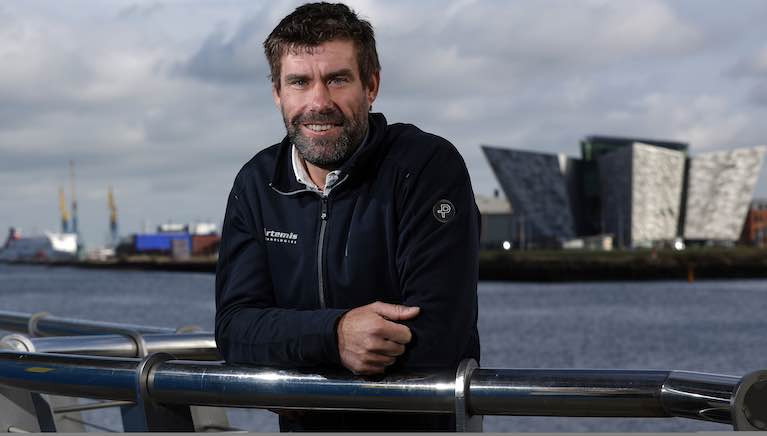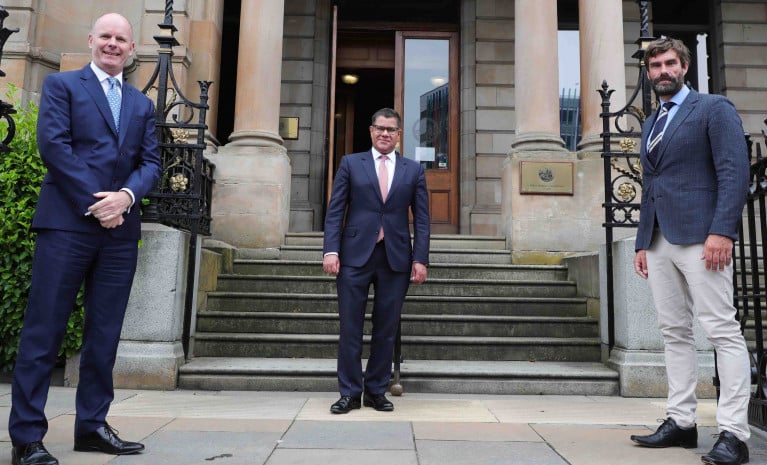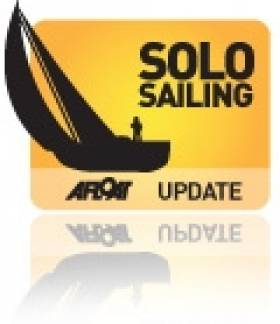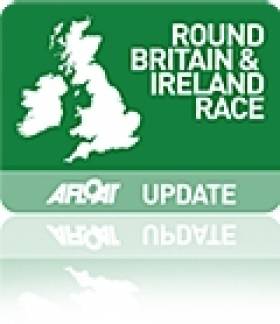Displaying items by tag: Artemis
Belfast Harbour and Artemis Technologies Work Together to Develop Cutting Edge Pilot Boat
In a collaboration between Belfast Harbour and Artemis, they have designed and developed the EF-12 Pilot as part of a Department for Transport UK Clean Maritime Demonstration Competition feasibility study.
Belfast Harbour is proud to have supported Artemis Technologies, a pioneering leader in the development of innovative maritime technologies, in designing and developing the ground-breaking Artemis EF-12 Pilot.
This cutting-edge pilot boat represents a major milestone in sustainable maritime solutions, combining advanced electric propulsion with cutting-edge hydrofoil technology to provide unmatched efficiency and safety in pilotage operations.
With a top speed of 32 knots and a foiling range of 55 nautical miles, the 100% electric Artemis EF-12 Pilot is testament to Artemis Technology’s strong commitment to environmental sustainability and the reduction of greenhouse gas emissions in the maritime industry.
This latest creation was supported by the UK Department for Transport’s Clean Maritime Demonstration competition (CMDC), with Artemis Technologies working closely in partnership with Belfast Harbour on a feasibility study regarding the potential of the Artemis eFoiler® technology to decarbonise global pilot boat operations.
The Artemis EF-12 Pilot was developed following interest from pilot boat operators across the globe, and will deliver market leading crew comfort and stability, whilst meeting the specific requirements unique to this challenging operation.
Uniquely the vessel’s ability to actively stabilise the vessel’s roll, pitch, and heave during the transfer of pilots, greatly reduces the risks associated with this important but dangerous manoeuvrer.
Dr Iain Percy OBE, CEO of Artemis Technologies, commented: “We are incredibly excited to introduce the Artemis EF-12 Pilot to the maritime industry. This innovative vessel is a testament to our commitment to sustainability and efficiency in maritime transportation. We believe the Artemis eFoiler® pilot boat will set new standards for pilotage operations globally.
During the 8-month feasibility study we undertook real world data collection & analysis of Belfast Harbour’s pilot operations allowing us to understand typical pilot vessel duty cycles and operational requirements. An exact virtual copy of Belfast Harbour’s existing pilot vessel was created and input into our Digital Twin tool-chain allowing a virtual study comparing the Artemis EF-12 Pilot design against this real-world operational pilot vessel.
Belfast Harbour stakeholders were involved throughout the whole process and validated the findings of the study through virtual design assessments, reviews of results, and virtual trials driving the EF-12 Pilot in our full-motion platform simulator.”
Analysis of the data collected during our research and testing has indicated that the Artemis EF-12 Pilot would deliver significant cost savings over the expected lifespan of a vessel, prevent the release of CO2e, and reduce the relative motions between pilot vessel and ship during pilot transfer, when compared to the current vessels working in this sector of the ports’ industry.
Jamie Faulkner, Deputy Harbour Master at Belfast Harbour, said: “The feasibility study allowed us to thoroughly examine the operation of our pilot boats, encompassing aspects such as fuel consumption, service and maintenance costs, and the environmental impact. It also enabled me to spend time on Artemis’ prototype vessel, Pioneer of Belfast. Whilst it was a great experience to be gliding through the port at 25 knots with virtually no wake, what was most important for us was the reduction in both noise and vibration, as well as improved stability at sea.
It’s been great to have the opportunity to collaborate closely with the team at Artemis Technologies, they have grasped the essential elements of pilot boat operations, when working on the design of the Artemis EF-12 Pilot.”
Artemis Technologies is dedicated to creating solutions that reduce the environmental impact of maritime operations while improving efficiency and safety. The Artemis EF-12 Pilot is a shining example of their commitment to innovation and sustainability.
For more information about the Artemis EF-12 Pilot and Artemis Technologies, visit HERE.
Belfast Lough Artemis Fast Ferry Boss Iain Percy Salutes UK's 'Green Industrial Revolution'
In response to the announcement by the Prime Minister Boris Johnson of a ten-point plan for a Green Industrial Revolution, Dr Iain Percy OBE, CEO, Artemis Technologies said:
“The Prime Minister’s blueprint for a ‘Green Industrial Revolution’ is a welcome boost to industries such as maritime as we aim to build a more sustainable future, and aligns with our plans to develop cleaner ships and maritime transport systems.
“With our vision to lead the decarbonisation of maritime, we are very much part of that revolution and are committed to helping the country meet its net-zero carbon target.
 The electric hydrofoil propulsion system, the Artemis eFoiler, is to be built in Belfast
The electric hydrofoil propulsion system, the Artemis eFoiler, is to be built in Belfast
“Our transformative electric hydrofoil propulsion system, the Artemis eFoilerTM, currently being developed with our partners in the Belfast Maritime Consortium, will enable the disruption of the market and power the high-speed green vessels of the future.
“The fast ferries to be designed and built in Belfast, will be capable of carrying over 350 passengers and will be zero-emission and require up to 90 per cent less energy than traditional high-speed ferries.
“This will have a huge impact, not just in maritime public transport, but also in sectors such as offshore energy, where the technology can be utilised to decarbonise operations.
”Together with the required increased investment on infrastructure at ports and across our cities, the UK can lead the world in clean energy and greener transport and we are proud to play our part.”
UK Business Minister Visits Belfast Maritime Consortium
The Belfast Maritime Consortium led by Artemis Technologies, has hosted a visit to the city by the Secretary of State for Business, Energy, and Industrial Strategy (BEIS), the Rt Hon Alok Sharma MP.
Representatives of the 13-partner syndicate met the minister to discuss their plans to develop zero-emissions ferries in Belfast that will revolutionise the future of maritime transport.
The project recently won a £33 million Strength in Places Fund grant from UK Research and Innovation (UKRI), a BEIS funded body
Iain Percy OBE, CEO of Artemis Technologies, a spin-off from competitive sailing team Artemis Racing, said:
“It was a pleasure to host the Secretary of State in Belfast to showcase our plans to make the city, and the UK, the global lead in zero emissions maritime technology.
“Along with our consortium partners, we took the opportunity to provide a detailed brief to the Minister on our plans to foster a newly resurgent maritime cluster in Northern Ireland that could create hundreds of jobs over the coming years.
“No matter who we meet, the excitement when we talk about combining Belfast’s shipbuilding heritage with its incredible talent in aerospace and composite engineering, and world-class R&D capabilities, is clear to see.
“Thanks to the support of BEIS and UKRI through the Strength in Places Fund, and with the assistance of our partners in industry, academia and the public sector, we can harness that potential and change the face of waterborne transport forever.”
During the visit, the Secretary of State met with members of the Belfast Maritime Consortium at Belfast Harbour, before previewing new exhibition space at the W5 interactive science museum featuring Artemis Racing’s America’s Cup high-speed yacht, and touring the Northern Ireland Advanced Composites and Engineering (NIACE) Centre, which will host part of the consortium’s R&D programme.
The Belfast Maritime Consortium project, which is being backed by close to £60m of investment over the next four years, including contributions from consortium partners will create an initial 125 research and development jobs leading to more than 1,000 in the region over the decade.
The Belfast consortium brings together a range of established and young firms, academia and public bodies, including Belfast Harbour, Bombardier Belfast, Northern Ireland Advanced Composites Engineering (NIACE), Creative Composites, Energia, Catalyst, Invest Northern Ireland, Ulster University, Belfast Met, Queen’s University, Belfast, Ards and North Down Borough Council, and Belfast City Council.
The Umpire Strikes Back! Artemis in America's Cup Collision
With just seconds to go to race two of the America's Cup World Series in Bermuda Artemis Racing managed by Iain Percy ended up in a pre-start collision with the umpire boat. There was damage, but no injuries... and amazingly Artemis went on to win the race.
Artemis Racing grabbed the lion's share of the spotlight, writing an epic comeback story on Sunday at the Louis Vuitton America's Cup World Series in Bermuda.
On the race course, the three double-point races had three different winners with Artemis Racing proving the most consistent performer on the day to take the win.
But this was an unlikely victory. Not only did the Swedish challenger arrive at the event in fifth place out of the six teams, but in the pre-start ahead of race two, the team was involved in a collision with an Umpire boat, incurring serious damage.
In work worthy of an F1 pit crew, the Artemis Racing squad stripped off the broken bow sprit and the now useless Code Zero sail in record time. After a quick check for reliability and with less than two minutes to spare, the team was lining up for the next start. Incredibly, they blasted of the starting line with more speed than anyone else and won not only the start but the second race.
In the third and final race, the Swedish team needed to make a pass on the last leg to grab a fourth place finish and secure the points needed to win the regatta.
Emirates Team New Zealand, with an impressive win in race three, extends its advantage on the Louis Vuitton America's Cup World Series leaderboard.
Louis Vuitton America's Cup World Series Bermuda Results
1. Artemis Racing: 2 - 1 - 4 - 52 points
2. Emirates Team New Zealand: 5 - 2 - 1- 50
3. ORACLE TEAM USA: 1 - 3 - 5 - 48
4. Land Rover BAR: 3 - 6 - 2 - 44
5. SoftBank Team Japan: 4 - 4 - 3 - 44
6. Groupama Team France: 6 - 5 - 6 - 32
More from Artemis Racing:
Artemis Racing claimed a dramatic victory in the final Louis Vuitton America's Cup World Series event of the year.
The team headed to Bermuda with plenty to prove, and after racing was abandoned on Saturday, three races were scheduled for Sunday.
Team Manager and Tactician, Iain Percy, spoke of his relief after a trying few months.
"I'm very proud of the team. We had a lot of pressure to perform. I know perfectly well that we have a talented enough team to win these events, but things haven’t gone our way, we’ve hit the odd rock and capsized, and suddenly everyone was questioning us.
To deliver under that heat, and under the circumstances of the crash, was pretty impressive".
Artemis Racing made a great start in race one, and led most of the way before being pipped by Oracle Team USA at the finish line. In the pre-start of race two, with just a few minutes of the countdown left, the team was involved in a collision with an Umpire boat, incurring serious damage, and it appeared that Artemis Racing would be knocked out of the event.
Just moments before the starting gun fired, the team ducked behind the Japanese boat, and as Outteridge turned up towards the line, he was confronted with an Umpire boat heading directly towards him. The closing speed would have been in excess of 25 knots.
“At that point we couldn’t go anywhere,” Outteridge explained. “He went straight between our bows but thankfully nobody was hurt. There was a serious amount of damage to our boat though.”
Iain Percy said, “my first thought was for the safety of the umpires on the boat, we were all pretty shaken up”.
The Artemis Racing squad stripped off the broken bowsprit and the now useless Code Zero sail in record time. After a quick check for reliability and with less than two minutes to spare, the team lined up for the next start. Incredibly, they blasted off the starting line with more speed than anyone else and won not only the start but also the second race.
Outteridge continued, “We owned that start… It was huge payback for all the hard work from the guys who stripped the gear off, checked the boat, and got us ready just in time.”
Iain Percy spoke of his admiration for his Skipper, "There really was no time for pep talks, and we were frantically ripping carbon and rope off the boat trying to clear it. Before we had a moment to breath, it was 1:30 to the start.
I have to say, what Nathan Outteridge displayed there, is why everyone says he’s so talented. I’m not sure there are many people in the world that could have showed that composure and nailed the start the way he did, absolutely incredible".
In the third and final race, the Swedish team needed to make a pass on the last leg, and pulled off a fantastic foiling gybe to grab a fourth place finish and secure the points needed to win the regatta.
Winning the Bermuda event means that Artemis Racing rises to fourth place in the overall series rankings, and puts an important marker down in the venue for the 35th America's Cup in 2017.
"To be the first team to win an event in Bermuda, the venue of the next America’s Cup is just great for our team. We love it here; we’ve been training here all year, getting ready for the main event in 2017. Our results elsewhere haven’t been great but all that matters is how well we sail in this venue", said Outteridge.
It was an important victory for the team who struggled in the first two events in Portsmouth and Gothenburg, and Iain Percy spoke of what it will mean for the wider group.
"We’re a big team, and for every one of the sailors to go out today and perform, is a real boost going into the winter. You can’t buy that; you can’t put a value on a team knowing 100% that they are here to win this competition. Everyone will be working that little bit harder, and we’re going to have that little spring in our step through the whole winter. It’s going to project us towards winning in 2017".
Louis Vuitton America’s Cup World Series Bermuda Results
1. Artemis Racing: 2 – 1 – 4 – 52 points
2. Emirates Team New Zealand: 5 – 2 – 1– 50 points
3. ORACLE TEAM USA: 1 – 3 – 5 – 48 points
4. Land Rover BAR: 3 – 6 – 2 – 44 points
5. SoftBank Team Japan: 4 – 4 – 3 – 44 points
6. Groupama Team France: 6 – 5 – 6 – 32 points
And from Team BAR:
Sir Ben Ainslie's British boat finished fourth in this third leg. Land Rover BAR came third in the first race, but endured a tough second round after a technical issue saw them slip from first to last place.
They came second in the final race, while the regatta was won by Artemis Racing who are led by Britain's two-time Olympic champion Iain Percy.
Land Rover BAR are third overall with Emirates Team New Zealand leading.
"It was one of those days. We're still third, we still feel we've got the best team and I believe we will win the World Series," said Land Rover BAR crew member David Carr after his team finished fourth out of the six boats that competed.
The Bermuda leg followed events in Portsmouth and Gothenburg this summer.
Light wind saw racing abandoned on Saturday in Bermuda, which will host the America's Cup itself in 2017, and three shorter rounds were held on Sunday.
The Bermuda leg is part of a lengthy qualification process that will count towards the 2017 America's Cup Challenger Series, the winner of which will take on Oracle in the 2017 America's Cup.
It will be the 35th staging of the oldest competition in international sport which was first raced in 1851 around the Isle of Wight.
Figaro Season Curtain Raiser Starts in Three Days
#AOAsolo – And they're off...nearly. Just three days now stand between Artemis Offshore Academy Rookies Rob Bunce (Artemis 37), Robin Elsey (Artemis 43), Andrew Baker (Artemis 23) and the first race of their solo offshore careers – the 196 mile Solo Basse Normandie starting 1430 CET on Friday 27th March. The Solo Basse Normandie is the litmus test for the Academy's intrepid Rookies. Have they learned enough? Have they practised enough? Will they be able to stay in the mix with the Classe Figaro Bénéteau's high calibre competitors? For Academy Alumni sailors Sam Matson (Chatham) and Alan Roberts (Magma Structures), the Solo Basse Normandie marks their first race as bona fide Figaro sailors, stepping out of the Rookie division and into the field after racing their first Solitaire du Figaro in 2014. For Jack Bouttell (GAC Concise), the race is the start of his third Classe Figaro Bénéteau season, while Nick Cherry (Redshift) and Henry Bomby (Rockfish Red) are preparing to kick start their fourth. For the British solo Figaro team, supported by the Artemis Offshore Academy, the future couldn't look brighter – the Academy's five Alumni skippers all securing promising partnerships with top UK businesses ahead of the season.
"Right now we are where we'd hoped to be in the Academy's evolution, with British companies seeing value in supporting the endeavours of our Alumni sailors and benefitting from their association," Charles Darbyshire, Artemis Offshore Academy Sailing Team Manager explained. "This benefit is not just in terms of media exposure, but also inspiring their employees and customers. While becoming a title/naming sponsor of a Figaro campaign is clearly a significant financial commitment, we've been impressed by the number of smaller sponsorships the Alumni sailors have been able to sign. This allows smaller companies to access the sailors, as well as giving bigger companies an opportunity to test the water with sailing sponsorship. The Academy has had to evolve from not only creating a British talent pool, but supporting it too. It's great to see eight British names on the entry list for the all important first race of the season – each skipper benefitting from varying degrees of Academy support. I hope the results on the water reflect the effort and energy that has gone in to each and every one of the British campaigns."
At just under 200 miles the Solo Basse Normandie looks set to be a short, but not so sweet race through some of the world's most tidal areas. On delivery to Granville, Jack and competitors from the Pôle Finistere Course au Large training centre were held up outside of the port, forced to anchor for seven hours after missing a vital tidal gate. Granville is notoriously hard town to reach by water, with a large sill preventing the Figaros entering or leaving the port at any time other than high tide. Add in to the mix a rugged coastline, debris and the Channel Islands and the Solo Basse Normandie competitors will have a lot to think about during their two intensely tactical days at sea.
"The Solo Basse Normandie course is extremely tidal" Ed Hill explained, a British Solitaire du Figaro competitor in 2013 and 2014. "It passes through the Alderney Raz, one of the most tidal areas in the world. If you have never been through there before it is an experience in itself. It can be a very frustrating time for a skipper, especially if the tide is against you. The course also slaloms around the Channel Islands, which are notoriously rocky. For the Rookies, there is going to be a lot to think about, especially over night. Twenty-four hours is a long time to have to stay in contention, stay awake and deal with everything that's going on. I think the race is going to be a real eye opener for them, both physically and mentally. There is a really strong turn out for the race this year and all the Brits are up against some really good sailors."
There are now 26 Figaro skippers signed up for the Solo Basse Normandie, ranging from top Solitaire du Figaro competitors Yann Elies, Paul Meilhat, Charlie Dalin and Vendée Globe winner Alain Gautier, to six ambitious Rookies including Rob, Robin and Andrew in the Academy's blue 'Bizuth' boats: "So far we've only sailed against each other and Benoit Mariette from the Rookie division, so measuring ourselves against Sophie Faguet and Martin Pape will be interesting," Robin explained. Along with Rob, Andrew and the Alumni sailors, Robin has spent his week in Granville pouring over charts and doing a recce of the area. "The wind is looking quite light for the race, which makes the tide even more important. I've sailed the area between Granville and Cherbourg quite a bit racing on the Royal Ocean Racing Club circuit and with a negative tide through the Alderney Raz, you'll see seven knots pushing against your boat. I'm hoping that we see a bit a breeze so that we won't need to drop anchor!"
The Solo Basse Normandie starts on Friday 27th March from Granville, France with the competitors expected to arrive in Cherbourg, France on Saturday 28th March.
The Solo Basse Normandie entry list:
Skipper/Figaro/Boat no./*Rookie
1. Paul Meilhat, SMA VOILE/ 4
2. Rob Bunce*, ARTEMIS 37 / 37
3. Robin Elsey*, ARTEMIS 43 / 43
4. Henry Bomby, ROCKFISH RED / 16
5. Yann Elies, GROUPE QUEGUINER LEUCEMIE ESPOIR / 26
6. Alan Roberts, MAGMA STRUCTURES / 85
7. Corentin Horeau, BRETAGNE CREDIT MUTUEL Performance / 3
8. Nick Cherry, REDSHIFT / 56
9. Yoann Richomme, SKIPPER MACIF 2014 / 79
10. Charlie Dalin, SKIPPER MACIF 2015 / 1
11. Martin Le Pape*, OVIMPEX Secours Populaire / 65
12. Benoît Mariette*, ENTREPOSE / 68
13. Thierry Chabagny, GEDIMAT / 8
14. Sébastien Simon, BRETAGNE CREDIT MUTUEL Espoir / 25
15. Alain Gautier, GENERALI 40 / 50
16. Alexis Loison, GROUPE FIVA / 9
17. Claire Pruvot, PORT DE CAEN OUISTREHAM / 55
18. Jackson Bouttell, GAC Concise / 19
19. Andrew Baker*, ARTEMIS 23 / 23
20. Sam Matson, ARTEMIS 21 / 21
21. Sophie Faguet*, REGION BASSE-NORMANDIE / 14
22. Arthur Prat, GUADELOUPE Grand Large 1 / 34
23. Nicolas Thomas, GUADELOUPE Grand Large 2 / 36
24. Gwénolé Gahinet, SAFRAN – Guy Cotten / 62
25. Isabelle Joschke, GENERALI Horizon Mixité
26. Adrien Hardy, AGIR RECOUVREMENT
Solo Sailing Conference Offers Charter of Performance Yachts
Irish solo sailing fans may be interested in the annual Solo Racing Festival at the Royal Southern Yacht Club, Hamble on Saturday 12th March.
Given the Figaro race is coming to Dun Laoghaire in August a talk on the Artemis Academy with John Thorn (Figaro 2) will be of particular interest.
Owen Clarke's designer Merfyn Owen, who lives in Hamble will be attending as well as colleagues from their brokerage partners Boatshed Performance.
So whether your interest be solo sailing or short-handed sailing in general they will be there to answer questions on design, construction, as well as sale/purchase and charter of offshore performance yachts.
The Race Fair is an open house from 10.00 for race organisers to meet and greet potential skippers from; Global Ocean/Class 40, Mocra, UK mini group, RORC, SORC, Biscay Challenge, AZAB. Floating boat show, 8 boats including the OC class 40, 2 minis, A35, J105, Figaro 2, Sunfast 3200.
There is a Book Signing, Alex Bennett signing copies of High Seas High Stakes and showing Fuji DVD Mike Golding is opening the talks at 11,00.
Followed by:
Winning Mind Set with Ian Brown, sports psychologist
Global Ocean race with Oliver Dewar
Two Star/Ostar with John Lewis, RWYC
30m trimaran design with Nigel Irens (Idec, Sodebo)
Artemis Academy first term report with John Thorn (Figaro 2)
Route du Rhum with Marco Nannini, (class 40)
all in the spendid riverside setting of the Royal Southern Yacht Club, Hamble.
More HERE.
Having crossed the Sevenstar Round Britain and Ireland Race finish line Monday at 00h32' 27'' after 6 days 10 hours 32 minutes and 27 seconds at sea, Artemis Ocean Racing II managed to break the IMOCA 60' course record at the end of an "epic day of full-on sailing", as Jonny Malbon said upon setting foot ashore.
The Sevenstar Round Britain and Ireland Race is special for Artemis Ocean Racing, as its 2006 edition was the first event the team's first IMOCA 60' (ex-Hexagon, later known as Artemis I) took part in - and incidentally won, with Jonny Malbon at the helm. And despite the "domestic" feel evoked by its course and appellation, it's a gruelling competition with 1802 nautical miles to cover - that's more than half of a transatlantic crossing - on a course that takes the sailors to the loneliness, the cold and the desolation of the Northern Hemisphere's high latitudes.
Last night, Jonny Malbon and his crew came back home to find the Solent as windy and choppy as they left it last Monday under reefed mainsail and Genoa jib, yet an awful lot has happened during this (mainly) fast and furious week, which saw five competitors, including the Super Maxi 100' ICAP Leopard, retire from the race after having suffered gear failure. For the first 3 days of the race, the breeze only dropped below 20 knots for a total combined time of a couple of hours, which means that the crew have had a very bumpy, wet and uncomfortable ride for starters.
Yet spirits were up, as Artemis Ocean Racing II is a powerful machine that needs strong conditions to fully express her potential, and as a results the boat speed was thrilling, as Jonny Malbon recalls: "As soon as we set off we were in 30 - 35 knots of wind, we knew it wasn't going to be plain sailing the whole way! It was a brutal start, with heavy airs, big seas and big speeds - fantastic to be off at such a pace! We made some good decisions and were up to the north really quickly. We had a few sticky patches off Muckle Flugga, and it was really painful to see the lead that we had melt away, but every time we managed to get going again quickly. I had my eyes on the time, and the boys were really on it, they did great job of always pushing the boat. We had another light patch this morning (Sunday) but when the breeze kicked at about 9 we had the most epic day - overpowered and on the edge, but totally enjoying it with speeds reaching 27 to 28 knots at times! We're knackered but it was fabulous..."
"The record has been in our minds from the start, and we're all really chuffed about it. The team spirit was great, it all worked perfectly and we had a really good time, it was nice to push the boat hard at all times and get the best out of her. We had some spectacular gybes and a few hairy moments, with a lot of laughter as soon as the boat had recovered and was back on track. Graham, Mikey and Gareth know the boat inside out, and it was also great to have Simon Hiscocks on board with us."
The IRC overall results won't be known until the "chasing pack" comes in, but at the moment it's looking very good for Artemis Ocean Racing who had a fabulous final day - so maybe one more victory to celebrate for the crew! Stay tuned.
Previous record
Dee Caffari / Sam Davies (Aviva) 2009 - 6 days, 11 hours, 30 minutes and 53 seconds.
Artemis Ocean Racing II crew
Jonny Malbon, skipper
Graham Tourell
Mike Ferguson
Gareth Rowley
Simon Hiscocks

































































